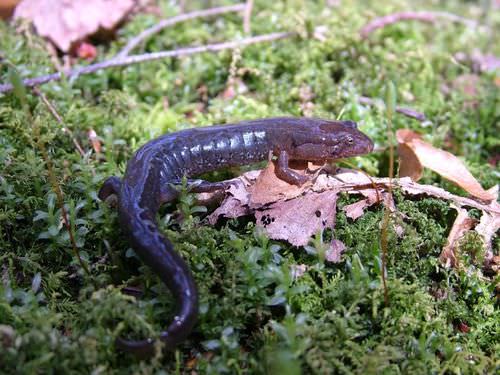10.7 两栖
章节大纲
-
What were the first land vertebrates ?
::第一批陆脊椎动物是什么?Amphibians! In order for water-dwelling animals to adapt to life on land, many new adaptations had to take place. First, they needed to be able to breathe air instead of obtaining oxygen from water. And fins don't work well as legs! They needed to be able to move around well on land.
::两栖动物!为了让住水的动物适应陆地上的生活,必须进行许多新的适应。 首先,它们需要能够呼吸空气,而不是从水中获取氧气。 鳍不能正常工作, 腿不能正常工作! 它们需要能够在陆地上移动。Characteristics of Amphibians
::两栖的特征What group of animals begins its life in the water, but then spends most of its life on land? Amphibians! Amphibians are a group of vertebrates that has adapted to live in both water and on land. Amphibian larvae are born and live in water, and they breathe using gills . The adults live on land for part of the time and breathe both through their skin and with their lungs as their lungs are not sufficient to provide the necessary amount of oxygen.
::哪种动物在水中开始生活,然后将其生命的大部分时间花在陆地上?两栖动物!两栖动物是既适应于水又适应于陆地的脊椎动物。两栖幼虫出生在水中,用刺来呼吸。成年动物在陆地上生活了部分时间,通过皮肤和肺呼吸,因为他们的肺不足以提供必要的氧气。There are approximately 6,000 species of amphibians. They have many different body types, physiologies, and habitats , ranging from tropical to subarctic regions. Frogs , toads , ( Figure ), newts , and caecilians are all types of amphibians.
::有大约6,000种两栖动物,它们有多种不同的身体类型、生理和生境,从热带到亚北极地区不等,青蛙、青蛙、青蛙(图 ) 、 和都是两栖动物。One of the many species of amphibian is this dusky salamander. How did Amphibians Adapt to Living on Land?
::两栖人如何适应陆地生活?Transition to life on land meant significant changes to both external and internal features. In order to live on land, amphibians replaced gills with another respiratory organ , the lungs. Other adaptations include:
::为了在陆地上生活,两栖动物用另一种呼吸器官,即肺代替刺。-
Skin that prevents loss of water.
::皮肤能防止水的流失 -
Eyelids that allow them to adapt to
outside of the water.
::眼皮能让它们适应水外 -
An
eardrum
developed to separate the external ear from the middle ear.
::耳膜是用来把外耳和中耳分开的 -
A tail that disappears in
(in frogs and toads).
::尾巴在(青蛙和青蛙)中消失。
Classification of the Amphibians
::两栖类分类Like , amphibians are ectothermic vertebrates. They belong to the class Amphibia. There are three orders:
::两栖动物是白脊椎动物,它们属于安菲比亚类。有三项命令:-
Urodela, containing salamanders and newts.
::Urodela, 装有和。 -
Anura, containing
.
::Anura, 包含 。 -
Apoda, containing caecilians.
::Apoda, 含有caecilians。 装有caecilians的Apoda。
Where do Amphibians Live?
::两栖人住在哪里?Most amphibians live in fresh water, not salt water. Their habitats can include areas close to springs, streams, rivers, lakes, swamps and ponds. They can be found in moist areas in forests , meadows and marshes. Amphibians can be found almost anywhere there is a source of fresh water. Although there are no true saltwater amphibians, a few can live in brackish (slightly salty) water. Some species do not need any water at all, and several species have also adapted to live in drier environments. Most amphibians still need water to lay their eggs .
::大多数两栖动物都生活在淡水中,而不是盐水中,其生境包括靠近泉水、溪流、河流、湖泊、沼泽和池塘的地区,它们存在于森林、草原和沼泽中的潮湿地区,几乎在任何地方都能找到淡水来源,虽然没有真正的咸水两栖动物,但有少数可以生活在咸水(浅咸)水中,有些物种根本不需要水,一些物种也适应了干旱环境,大多数两栖动物仍然需要水来产卵。How do Amphibians Reproduce?
::两栖生物如何繁殖?Amphibians reproduce sexually. The life cycle of amphibians happens in the following stages:
::两栖动物在性方面繁殖。两栖动物的生命周期在以下阶段发生:-
Egg Stage: Amphibian eggs are fertilized in a number of ways.
External fertilization
, employed by most frogs and toads, involves a male gripping a female across her back, almost as if he is squeezing the eggs out of her. The male releases
over the female's eggs as they are laid. Another method is used by salamanders, whereby the male deposits a packet of sperm onto the ground. The female then pulls it into her
cloaca
, a single opening for her internal
organ systems
. Therefore,
occurs internally. By contrast, caecilians and tailed frogs use
internal fertilization
, just like
,
, and
mammals
. The male deposits sperm directly into the female's cloaca.
::卵子阶段: 以多种方式对两栖卵施肥。 多数青蛙和青蛙都使用外部施肥, 男性用外施肥, 将雌性围在她的背上, 几乎仿佛将雌性卵挤出。 雄性卵在产卵时释放出雌性卵。 另一种方法由土豆人使用, 雄性将一包精子储存在地上。 雌性随后将精子拉入她的木薯中, 雌性将精子放入她的内器官系统的一个单一的开口。 因此, 内部也存在。 相反, 野生和尾随的青蛙使用内部施肥, 就像哺乳动物一样。 雄性精子将精子直接储存在雌性树中 。 -
Larval stage: When the egg hatches, the
organism
is legless, lives in water, and breathes with gills, resembling their evolutionary
ancestors
(fish).
::彩虹阶段:当卵孵化时,有机体是无腿的,生活在水中,呼吸时有刺,类似于它们的进化祖先(鱼类)。 -
During the larval stage, the amphibian slowly transforms into an adult by losing its gills and growing four legs. Once development is complete, it can live on land.
::在幼虫阶段,两栖动物通过失去刺和长四条腿慢慢地变成人。 一旦发展完成,它就可以在陆地上生活。
Summary
::摘要-
Amphibians live in both water and on land; amphibian larvae are born and live in water, and they breathe using gills. The adults live on land for part of the time and breathe both through their skin and with their lungs.
::两栖动物既生活在水中,也生活在陆地上;两栖幼虫出生并生活在水中,他们用呼吸;成年人部分时间在陆地上生活,通过皮肤和肺呼吸。 -
Adaptations for land in amphibians include protective skin and eyelids that allow them to adapt to vision outside of the water.
::两栖动物对土地的适应包括保护性皮肤和眼皮,使他们能够适应水外的视觉。
Explore More
::探索更多Use the resources below to answer the questions that follow.
::利用以下资源回答以下问题。Explore More I
::探索更多-
Britannica Kids
- Amphibians
at
::英国儿童-两栖人
-
Describe the skin of an amphibian.
::描述两栖动物的皮肤。 -
What is metamorphosis?
::什么是变形? -
What is meant by "ectothermic" (
cold-blooded)
? How does this affect an animal's behavior?
::什么是“热血病”(冷血病)?这如何影响动物的行为?
Review
::回顾-
List three adaptions amphibians have for life on land?
::列出三只两栖生物在陆地上的生活适应情况? -
List four examples of amphibians.
::列举四类两栖动物的例子。 -
How do amphibians reproduce?
::两栖如何繁殖? -
Describe the amphibian larval stage. What changes occur during this stage?
::描述两栖幼虫阶段。 在这一阶段发生什么变化?
-
Skin that prevents loss of water.

